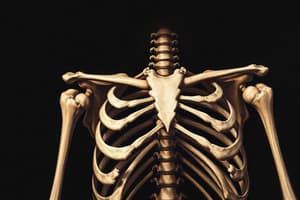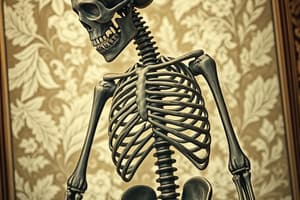Podcast
Questions and Answers
Which type of bone cell is responsible for the breakdown of bone tissue?
Which type of bone cell is responsible for the breakdown of bone tissue?
- Osteoblast
- Osteoprogenitor
- Osteocyte
- Osteoclast (correct)
What is the main function of osteoblasts within bone tissue?
What is the main function of osteoblasts within bone tissue?
- To break down bone tissue and release minerals
- To maintain daily metabolism of bones
- To undergo cell division and develop into osteocytes
- To initiate calcification and secrete collagen fibers for the extracellular matrix (correct)
Which of the following best describes the function of articular cartilage?
Which of the following best describes the function of articular cartilage?
- It reduces friction and absorbs shock at joints. (correct)
- It aids in the formation of blood cells.
- It provides a site for tendon attachment.
- It facilitates bone growth at the epiphyseal plate.
Which component is NOT a part of an osteon structure in compact bone?
Which component is NOT a part of an osteon structure in compact bone?
Which of the following best describes the function of compact bone tissue?
Which of the following best describes the function of compact bone tissue?
The region of a long bone between the diaphysis and the epiphysis is known as the:
The region of a long bone between the diaphysis and the epiphysis is known as the:
What is the primary role of osteocytes?
What is the primary role of osteocytes?
What is the primary role of the periosteum in bone structure?
What is the primary role of the periosteum in bone structure?
Which of these anatomical features is most closely associated with the production of blood cells during bone growth?
Which of these anatomical features is most closely associated with the production of blood cells during bone growth?
The endosteum is a thin membrane that:
The endosteum is a thin membrane that:
What is the primary focus of osteology?
What is the primary focus of osteology?
Which of the following is NOT considered a primary function of the skeletal system?
Which of the following is NOT considered a primary function of the skeletal system?
What is the process of blood cell formation within the bone marrow called?
What is the process of blood cell formation within the bone marrow called?
Which type of bone is primarily responsible for storing triglycerides?
Which type of bone is primarily responsible for storing triglycerides?
What is the approximate number of red blood cells produced by red bone marrow every second?
What is the approximate number of red blood cells produced by red bone marrow every second?
What percentage of the body's total calcium is stored in bones?
What percentage of the body's total calcium is stored in bones?
Which of the following is NOT one of the five primary types of bones?
Which of the following is NOT one of the five primary types of bones?
What is a key characteristic of bone tissue, referring to its constant modification?
What is a key characteristic of bone tissue, referring to its constant modification?
What is the mesenchymal covering that develops around the cartilage model called?
What is the mesenchymal covering that develops around the cartilage model called?
What are the cells called once chondroblasts become embedded in cartilage extracellular matrix?
What are the cells called once chondroblasts become embedded in cartilage extracellular matrix?
Which process describes the growth of cartilage in length?
Which process describes the growth of cartilage in length?
What stimulates osteoprogenitor cells to differentiate into osteoblasts during the formation of the primary ossification center?
What stimulates osteoprogenitor cells to differentiate into osteoblasts during the formation of the primary ossification center?
What is the periosteum initially known as before it starts forming bone?
What is the periosteum initially known as before it starts forming bone?
What are the small channels radiating from lacunae in compact bone tissue called?
What are the small channels radiating from lacunae in compact bone tissue called?
Which of the following best describes the structure of spongy bone tissue?
Which of the following best describes the structure of spongy bone tissue?
Where is spongy bone tissue typically located?
Where is spongy bone tissue typically located?
What is the main difference between intramembranous and endochondral ossification?
What is the main difference between intramembranous and endochondral ossification?
What is the first step in endochondral ossification?
What is the first step in endochondral ossification?
What are the thin columns of bone that make up spongy bone tissue called?
What are the thin columns of bone that make up spongy bone tissue called?
What are the spaces between trabeculae in spongy bone tissue normally filled with?
What are the spaces between trabeculae in spongy bone tissue normally filled with?
Which type of bone is formed by intramembranous ossification?
Which type of bone is formed by intramembranous ossification?
Which event occurs first during bone growth in thickness?
Which event occurs first during bone growth in thickness?
In the zone of hypertrophic cartilage, which of the following is most characteristic of the chondrocytes?
In the zone of hypertrophic cartilage, which of the following is most characteristic of the chondrocytes?
What is the primary function of osteoclasts during endochondral ossification?
What is the primary function of osteoclasts during endochondral ossification?
What is the final result of cartilage calcification and replacement in the diaphysis?
What is the final result of cartilage calcification and replacement in the diaphysis?
Which of the following accurately describes the chondrocytes in the zone of proliferating cartilage?
Which of the following accurately describes the chondrocytes in the zone of proliferating cartilage?
What is the sequence of differentiation during endochondral ossification?
What is the sequence of differentiation during endochondral ossification?
Which of the following best describes the role of osteoblasts in bone formation?
Which of the following best describes the role of osteoblasts in bone formation?
Which cell type is responsible for maintaining the bone extracellular matrix?
Which cell type is responsible for maintaining the bone extracellular matrix?
Flashcards
What is osteology?
What is osteology?
The study of bone structure and treatment of bone disorders.
How does bone remodel itself?
How does bone remodel itself?
Bone is a dynamic tissue constantly rebuilding itself by breaking down old bone and creating new bone.
What is the skeletal system?
What is the skeletal system?
The framework of bones including cartilage.
What is the primary function of bones in regards to support?
What is the primary function of bones in regards to support?
Signup and view all the flashcards
How do bones provide protection?
How do bones provide protection?
Signup and view all the flashcards
How do bones assist in movement?
How do bones assist in movement?
Signup and view all the flashcards
How do bones store and release minerals?
How do bones store and release minerals?
Signup and view all the flashcards
What vital process occurs within red bone marrow?
What vital process occurs within red bone marrow?
Signup and view all the flashcards
Diaphysis
Diaphysis
Signup and view all the flashcards
Epiphysis
Epiphysis
Signup and view all the flashcards
Metaphysis
Metaphysis
Signup and view all the flashcards
Articular Cartilage
Articular Cartilage
Signup and view all the flashcards
Periosteum
Periosteum
Signup and view all the flashcards
Osteoblasts
Osteoblasts
Signup and view all the flashcards
Osteocytes
Osteocytes
Signup and view all the flashcards
Osteoclasts
Osteoclasts
Signup and view all the flashcards
Osteon
Osteon
Signup and view all the flashcards
Compact Bone
Compact Bone
Signup and view all the flashcards
What are lacunae in compact bone tissue?
What are lacunae in compact bone tissue?
Signup and view all the flashcards
What are canaliculi in compact bone tissue?
What are canaliculi in compact bone tissue?
Signup and view all the flashcards
What is spongy bone tissue?
What is spongy bone tissue?
Signup and view all the flashcards
What are trabeculae in spongy bone tissue?
What are trabeculae in spongy bone tissue?
Signup and view all the flashcards
What is ossification?
What is ossification?
Signup and view all the flashcards
What is intramembranous ossification?
What is intramembranous ossification?
Signup and view all the flashcards
What is endochondral ossification?
What is endochondral ossification?
Signup and view all the flashcards
What happens in the first step of endochondral ossification?
What happens in the first step of endochondral ossification?
Signup and view all the flashcards
Perichondrium
Perichondrium
Signup and view all the flashcards
Chondroblasts
Chondroblasts
Signup and view all the flashcards
Interstitial Growth
Interstitial Growth
Signup and view all the flashcards
Appositional Growth
Appositional Growth
Signup and view all the flashcards
Primary Ossification Center
Primary Ossification Center
Signup and view all the flashcards
Zone of proliferating cartilage
Zone of proliferating cartilage
Signup and view all the flashcards
Zone of hypertrophic cartilage
Zone of hypertrophic cartilage
Signup and view all the flashcards
Zone of calcified cartilage
Zone of calcified cartilage
Signup and view all the flashcards
Endochondral ossification
Endochondral ossification
Signup and view all the flashcards
Study Notes
Bone Tissue Overview
- Bone (osseous) tissue is composed of various tissues working together
- Bone serves many purposes beyond simple support for muscles
- Bone is continuously remodeling, which involves the building of new bone and the breaking down of old bone
- Osteology is the study of bone structure and treatment of bone disorders
- The skeletal system is the entire framework of the bones and their cartilages
Types of Bones
- The adult human skeleton has 206 individual bones
- Five main types of bones are long, short, flat, irregular, and sesamoid
- The shapes of bones are largely determined by their functions
Anatomy of a Bone
- A typical long bone like the humerus consists of four main parts:
- Diaphysis: the bone shaft or body
- Epiphysis: the proximal and distal ends of the bone
- Metaphysis: the regions between the diaphysis and epiphysis
- Epiphyseal (growth) plate (only in growing bones)
- Articular cartilage: Thin layer of hyaline cartilage covering part of epiphysis to reduce friction and absorb shock
- Periosteum: Tough connective tissue associated with blood supply, helps in fracture repair, nourishing bone, and attachment for ligaments and tendons
- Medullary Cavity: Contains yellow bone marrow(fat storage) in adults and contains blood vessels; the marrow cavity
- Endosteum: Thin membrane lining the medullary cavity
Functions of Bones
- Support: The skeleton forms a structural framework for the body
- Protection: The skeleton protects important internal organs from damage
- Assistance in Movement: Skeletal muscles attach to bones, and their contractions result in movement
- Mineral storage and release: Bones store 99% of the body's calcium; they also store phosphorus, releasing and retrieving minerals as needed
- Blood cell production: Red bone marrow (a connective tissue) in certain bones produces red blood cells, white blood cells, and platelets; called hemopoiesis
- Triglyceride storage: Yellow bone marrow (adipose tissue) stores triglycerides, providing an energy source
Histology of Bone Tissue
- Compact Bone Tissue:
- Dense bone, observed on bone surfaces, composing the bulk of the long bone diaphysis
- Composed of repeated structural units called osteons (made of concentric lamellae arranged around osteonic canals containing blood vessels and nerves)
- Spaces between lamellae are called lacunae which contain osteocytes
- Radiating from lacunae are small channels called canaliculi filled with extracellular fluid to allow osteocytes to communicate
- Spongy Bone Tissue:
- Also referred to as trabecular bone tissue
- Located inside bones, protected by compact bone
- Consists of trabeculae (thin columns) made up of lamellae
- Spaces between trabeculae contain red and yellow bone marrow
Bone Formation
- Osteogenesis (ossification): The process of bone formation involving two types of ossification
- Intramembranous ossification: A simple method where bone forms directly from mesenchyme. Flat bones are examples
- Endochondral ossification: Cartilage is first formed, then the bone develops within it. Cartilage is replaced by bone tissue. Bones in the body are generally formed from this method.
- Key Steps (Endochondral) of the Process
- Development of the cartilage model
- Growth of the cartilage model
- Primary ossification center development
- Formation of the medullary cavity by osteoclasts
- Development of secondary ossification centers
- Formation of the articular cartilage and epiphyseal plate
Bone Growth
- Bone growth in length:
- Occurs at the epiphyseal plate
- Four zones of cartilage: resting, proliferating, hypertrophic, and calcified
- Bone growth in thickness (appositional growth):
- Occurs at the surface of the bone
- Ridges in the periosteum create grooves for blood vessels
- Periosteum ridges fuse to form tunnels
- Osteoblasts build new lamellae
- Bone grows outward toward the tunnel creating new osteons
Bone Cells
- Osteoprogenitor cells: Stem cells that develop into osteoblasts
- Osteoblasts: Bone-building cells that secrete collagen fibers and other organic compounds to form extracellular matrix, initiate calcification
- Osteocytes: Mature bone cells that maintain daily metabolism of bones
- Osteoclasts: Break down bone (bone resorption), release acids, and lysosomal enzymes to break down bone, originating from white blood cells
Studying That Suits You
Use AI to generate personalized quizzes and flashcards to suit your learning preferences.
Related Documents
Description
Test your knowledge on osteology with this comprehensive quiz. Explore key concepts such as the roles of various bone cells, the structure of compact bone, and the functions of the skeletal system. Perfect for students delving into bone anatomy and physiology.




